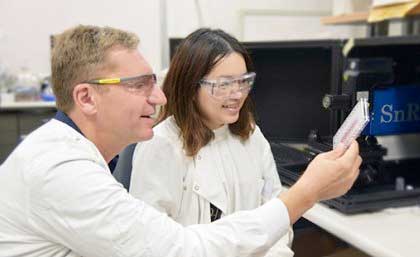| Posted: Apr 19, 2018 |
New cancer monitoring technology worth its weight in gold
(Nanowerk News) A new blood test using gold nanoparticles could soon give oncologists an early and more accurate prognosis of how cancer treatment is progressing and help guide the on-going therapy of patients.
|
|
Researchers at The University of Queensland have developed new nanotechnology to monitor the diversity of individual cancer cells circulating in the body (Nature Communications, "Characterising the phenotypic evolution of circulating tumour cells during treatment").
|
|
In close collaboration with oncologists at the Olivia Newton John Cancer Research Institute (ONJCRI), the technology was tested on blood samples from melanoma patients and was able to track critical changes in spreading tumour cells before, during and after treatment.
|
|
UQ’s Australian Institute for Bioengineering and Nanotechnology (AIBN) PhD student Jing Wang said the simple nanotechnology looked at changes in circulating tumour cells, which could indicate whether a cancer is attempting to spread and reveal its response to treatment.
|
 |
| Professor Matt Trau and PhD student Jing Wang.
|
|
“Circulating tumour cells (CTCs) have been shed by the original tumour and entered the bloodstream – they can then form into new tumours if they lodge in distant tissue,” Ms Wang said.
|
|
“CTCs can be found in the blood by looking for distinctive proteins on their surface, but the current process is time consuming and can typically only identify one type of CTC protein at a time.”
|
|
Ms Wang said this was an issue because the types of proteins on the surfaces of CTCs could vary from one type of cancer to another, and even within in the same cancer.
|
|
“If you go looking for just one kind of protein, you can miss a lot of CTCs,” she said.
|
|
“We have developed a simple technology which uses a special type of gold nanoparticle attached to different antibodies, which can stick to different proteins on a wide variety of CTCs.
|
|
“These nanoparticles emit a unique barcoded signal when hit with laser light, and this signal changes ever so slightly if that nanoparticle encounters a CTC and sticks to it, making them easy to detect.”
|
|
With the help of oncology collaborators at the ONJCRI, the researchers demonstrated that the diagnostic approach could be easily translated to the clinic.
|
|
The gold nanoparticle technology was tested on blood samples taken from melanoma patients during of the course of cancer treatment.
|
|
The technology successfully tracked in real-time how the diversity of tumour cell populations were changing in response to particular therapies for all of the patients studied, and was highly predictive of treatment effectiveness and patient outcomes.
|
|
AIBN researcher Professor Matt Trau said they hope the technology can be developed into a simple hand-held device.
|
|
“The gold nanoparticle technology is easy to use and extremely sensitive to CTC diversity – it can detect multiple types simultaneously down to as few as 10 CTCs in a 1 millilitre blood sample – and we saw dramatic changes during treatment for all patients studied,” Professor Trau said.
|
|
Olivia Newton John Cancer Research Institute’s Medical Director Professor Jonathan Cebon said having information about changes at a cellular level had the potential to guide cancer therapy in real-time.
|
|
“Signs of drug resistance can be identified which can help doctors and patients make informed decisions about treatment,” Professor Cebon said.
|
|
“The technology could also greatly improve our ability to study how tumour cells change in response to treatment and could help answer important biological questions about how treatment resistance arises.”
|

